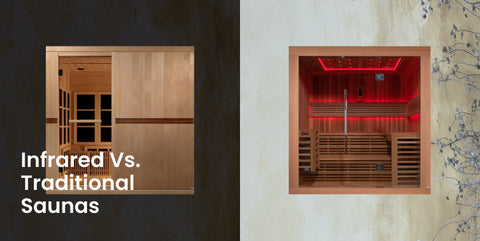
Saunas have long been valued for their ability to relax and refresh the body. With the continual development of technology, two prominent rivals in the field of sauna experiences have emerged: the Infrared Sauna and the Traditional Sauna. While both have various benefits, they appeal to different tastes and health objectives. In this article, we'll look at the unique characteristics, benefits, and difficulties of each sauna type to help you decide which one is ideal for you.
Let’s Understand Sauna and Its Types
What Is Sauna?
A sauna is a tiny space with a high temperature, usually between 150 and 195 degrees Fahrenheit. Saunas are frequently utilized for physical and mental well-being. Saunas are classified into two categories: infrared saunas and traditional saunas.
What Is the Major Differences between Infrared saunas and Traditional saunas?
Infrared Sauna:

- Infrared saunas release radiant heat from specialist infrared heaters. This heat immediately enters the body, raising core temperature and promoting perspiration while not considerably warming the air within the sauna.
- Infrared saunas, which operate at lower temperatures of roughly 120-150°F (49-66°C), are appropriate for people who find regular saunas too hot. They also maintain reduced humidity levels, making the experience gentler and more enjoyable.
- Infrared sauna proponents argue that the deeper heat penetration can help in the release of toxins held in fat cells, resulting in improved detoxification. Sweating in an infrared sauna may include more heavy metals and pollutants than sweating in a regular sauna.
- Infrared saunas, according to proponents, provide
Benefits such as enhanced circulation, relaxation, pain alleviation, and skin cleaning. Preliminary study points to possible cardiovascular benefits, but further research is needed for definitive proof.
Infrared saunas are quite simple to set up, generally requiring just a few tools. They are available as freestanding or portable devices, making them suited for a variety of settings. Infrared heaters must be cleaned and monitored on a regular basis for maintenance.
Traditional Saunas:

- Traditional saunas heat the air in the sauna area with heated pebbles or burners. This procedure raises the temperature of the surrounding environment, encouraging perspiration and detoxifying through the skin.
- Traditional saunas are distinguished by their higher working temperatures, which range from 160-200°F (71-93°C). The combination of dry air and bursts of steam produced by adding water to the heated pebbles can heighten the sweating sensation.
- Traditional saunas generate sweating, which assists in detoxification by releasing toxins through perspiration. Although the heat may not penetrate as far as it does in infrared saunas, the sweating process is nevertheless efficient.
- Traditional saunas are well-known for their calming effects as well as for possible cardiovascular benefits. According to research, greater blood pressure management and heart rate variability contribute to better heart health.
Pros and Cons of Infrared saunas and Traditional saunas?
Infrared Saunas:
Pros
- Temperatures that are suited for a wider readership.
- Heat that penetrates deeper may help in toxin release.
- Potential cardiovascular advantages.
- Installation is simple, and upkeep is minimal.
Cons
Traditional Saunas:
Pros:
- Intense heat causes substantial perspiration and detoxifying.
- Cardiovascular advantages have been established.
- Historical and cultural significance.
Cons
- Higher temperatures might be difficult for certain people.
- Installation and potential maintenance will be more involved.
Which Sauna Is the Best Fit for You?

The decision between an infrared sauna and a regular sauna is based on your own preferences, health goals, and level of heat comfort. If you want a gentler, more approachable heat sensation, an infrared sauna may be the best option. A traditional sauna, on the other hand, may be a better choice if you prefer the challenge of greater temperatures and wish to embrace the cultural tradition of saunas.
At last, both infrared and regular saunas have distinct advantages and disadvantages. Including frequent sauna sessions in your health routine, regardless of the style, may help with relaxation, cleansing, and general well-being. The final selection is based on your own tastes and how you want to feel the revitalizing benefits of heat treatment.



